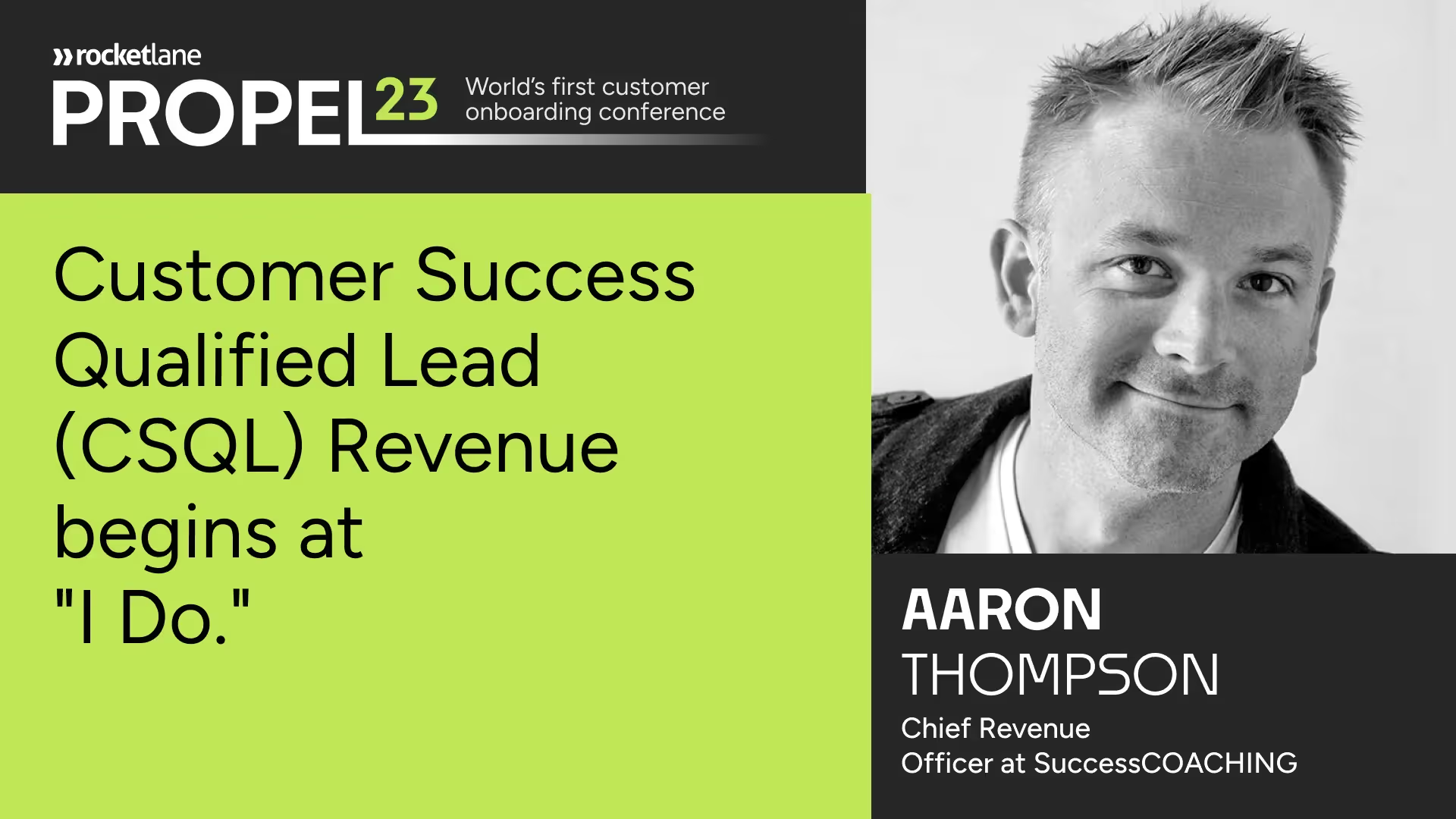In the field of Customer Success, there is a perpetual pursuit to get a seat at the revenue table. We often know our impact on revenue generation; however, quantifying this influence poses a challenge. Moreover, effectively communicating this impact to top-level executives, including the leadership team and board, is often difficult.
In his session at Propel23, Aaron went through the different types of revenue streams, RAC, CAC, how Customer Success Qualified Leads (CSQLs) affect revenue, and the impact of customer onboarding on revenue.
RAC vs CAC
Aaron commenced by explaining the distinction between RAC and CAC. Those familiar with customer success are likely acquainted with CAC, which stands for the Cost of Customer Acquisition. However, Aaron aimed to shed light on the concept of Revenue Acquisition Cost (RAC).
RAC takes a more comprehensive approach to revenue realization, emphasizing that not all revenue generated is of equal value. Some leads and customers incur higher costs. This approach highlights different revenue streams, their associated overhead, and acquisition costs for each customer. The company's ability to influence these streams and manage revenue acquisition costs significantly impacts revenue growth. This approach goes beyond customer acquisition cost, aiming for a three-to-one ratio between customer lifetime value (CLTV) and customer acquisition costs (CAC). Simply breaking even is inadequate, given the involvement of marketing, sales, operations, onboarding, implementation, configuration, and other vital components for delivering solutions to customers' business challenges. Generating enough post-sale revenue is essential to offset the acquisition costs.
Aaron points out that not all revenue is created equal. Different revenue types have varying levels of overhead, acquisition difficulty, and delivery challenges. To comprehend revenue acquisition costs, it is crucial to understand the specific revenue streams per customer and how they are measured. Demonstrating key performance indicators through metrics and actual KPIs allows for a tangible measurement of the impact on financial outcomes.
RAC gains particular importance in the current economic climate, especially when the market tightens, and acquiring new customers becomes more challenging. Measuring the different types of revenue that existing customers contribute to overall performance, both top and bottom lines, becomes crucial.
The different types of revenue
Aaron discussed various types of revenue that correspond to different stages in the customer journey, each with its own revenue acquisition cost. In the realm of customer success, the impact of customer onboarding on these revenue types varies. The main revenue types to be monitored include:
1. Net new revenue
This occurs when a customer progresses from the top to the bottom of the sales funnel, transitioning from the initial marketing efforts to the point of becoming a customer.
2. Renewal revenue
Generated when a customer makes subsequent purchases of the same product or service. The acquisition costs for renewal revenue differ from those of net new revenue.
3. Upsell revenue
Occurs when a customer spends more or purchases additional products or services from the same provider.
4. Cross-selling revenue
Involves customers purchasing something different that complements the initial product or service.
5. Referral revenue
Involves a new person purchasing the product or service based on a referral from a previous customer.
Aaron emphasizes the significance of the initial customer's advocacy and word-of-mouth referrals. These lead to Customer Success Qualified Leads (CSQLs) entering the sales funnel without the need for marketing expenses aimed at demand generation and awareness. Consequently, the acquisition cost for this type of revenue is significantly lower.
The ability to generate net new business without relying on conventional Marketing Qualified Leads (MQL) and Sales Qualified Leads (SQL) can lead to higher conversion rates, expedited deal closures, and reduced customer acquisition costs. In essence, it contributes to lowering the overall revenue acquisition cost.
How RAC applies to each revenue type
To explain revenue acquisition costs (RAC) for each type of revenue, Aaron uses ratios to understand the relative expense of each type, rather than specific dollar amounts.
Net new revenue incurs the highest RAC due to extensive efforts involved in demand generation, awareness, and the sales cycle.
Renewal revenue has the lowest RAC ratio since it doesn't require additional marketing efforts or an involved sales process.
Upsell revenue falls in the middle tier of revenue acquisition costs, which may involve some training.
Cross-sell revenue also falls in the middle in terms of acquisition costs, usually involving a sales process.
Advocate referral revenue has the lowest acquisition cost, costing only 1/13 of acquiring customers through traditional MQL and SQL routes.
Which types of revenue do CSQLs affect?
Customer Success Qualified Leads (CSQLs) represent new revenue generated for the business, serving as a tangible metric when aiming to increase revenue and engage in revenue-focused conversations. Net new revenue does not fall under CSQL revenue since marketing and sales have already gone through the process without customer success involvement by the time it is incurred.
Renewal revenue may or may not be influenced by customer success and onboarding efforts, depending on factors such as post-sale experiences and product-service fit.
The categorization of renewal revenue as a CSQL is subject to individual interpretation and assessment.
In contrast, upsell revenue definitively falls under CSQL. If customers are willing to spend more or purchase additional products/services from the same provider, it is a clear indication that they have achieved their desired definition of success. This indicates a clear customer success qualified lead. Similarly, if customers decide to buy other items, it suggests that the provider has effectively solved their problems using the initial product/offering. This also qualifies as a CSQL.
Lastly, the holy grail of CSQL is referral revenue, which enters through the "side door". Customers will only generate referral revenue if their desired definition of success, comprising outcomes and a desired experience, has been delivered. If the provider fails to meet these expectations, customers will be unlikely to advocate and generate referral revenue. However, if the provider does meet expectations, referrals will occur. Therefore, referral revenue serves as a key indicator of successful customer success qualified leads.
Overall, these three types of revenue – upsell, cross-sell, and referral–can be attributed to CSQLs.
The impact of customer onboarding on revenue
Effective customer onboarding is essential to ensure a smooth transition from the decision to become a customer to the delivery of promises made during the sales process. This transition marks a shift from the top of the sales funnel to the bottom, where the provider must deliver on their commitments.
Four key elements come into play during onboarding:
1. Relationship transition: Customers encounter a new dynamic as they interact with different individuals during onboarding, creating a unique relationship.
2. Siloed data challenge: Information gathered about the customer must be seamlessly carried over from the top to the bottom of the funnel to ensure a smooth customer journey.
3. Addressing buyer's remorse: Providers must overcome doubts or concerns that customers may have after deciding to become a customer.
4. Activation stage: Successfully navigating these challenges sets the stage for various revenue types, and tools like Rocketlane can help address these challenges effectively.
Common mistakes to avoid during customer onboarding
90% of customers who churn do so within the first 30 days of working with the company. This emphasizes the crucial nature of onboarding. The ability to renew customers is directly tied to successful onboarding.
Common mistakes to avoid during onboarding include failing to handle handoffs effectively, involving too many individuals, and lacking adaptability to meet the customer's specific needs.
Tools like Rocketlane aim to eliminate friction in the customer onboarding process, reducing time-to-value (TTV) and facilitating the transition from activation to optimization as quickly as possible. This establishes successful onboarding and renewal revenue streams.
If customers fail to renew, it hinders cross-selling opportunities and customer advocacy, leading to a lack of referral revenue. Therefore, the success of all revenue streams ultimately relies on effective onboarding.
In other words, the key to maximizing revenue generation lies in the performance of the onboarding stage.
Year One renewal vs Year Two renewal
The impact on revenue acquisition costs across consecutive years may vary depending on specific factors. While companies may not need additional marketing efforts in subsequent years, there may be overheads and training efforts involved in subsequent years. Factors like turnover and changes in the user base could influence the overall costs.
However, the core function of creating a renewal remains consistent across different years. The key considerations are whether customers achieve their definition of success by receiving the desired outcomes, and whether the experience meets their expectations.
Tracking CSQL revenue
More people now recognize the importance of measuring CSQL.
To gain a seat at the revenue table, Aaron firmly believes, you need to quantitatively demonstrate the impact on revenue and the various revenue streams within an account, be it renewal or expansion revenue. Though it may require additional effort, It is possible to trace back and identify where CSQL originated.















